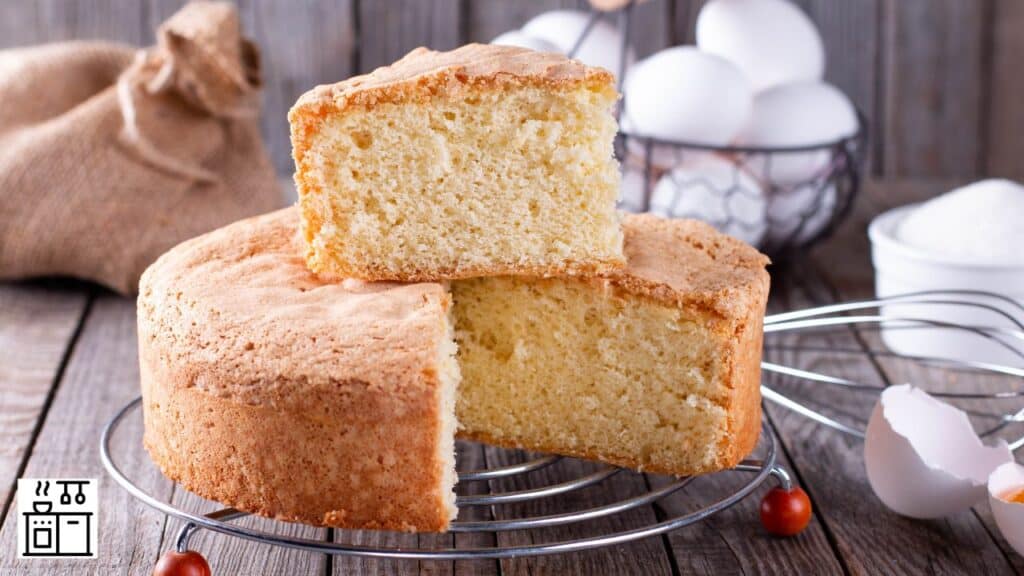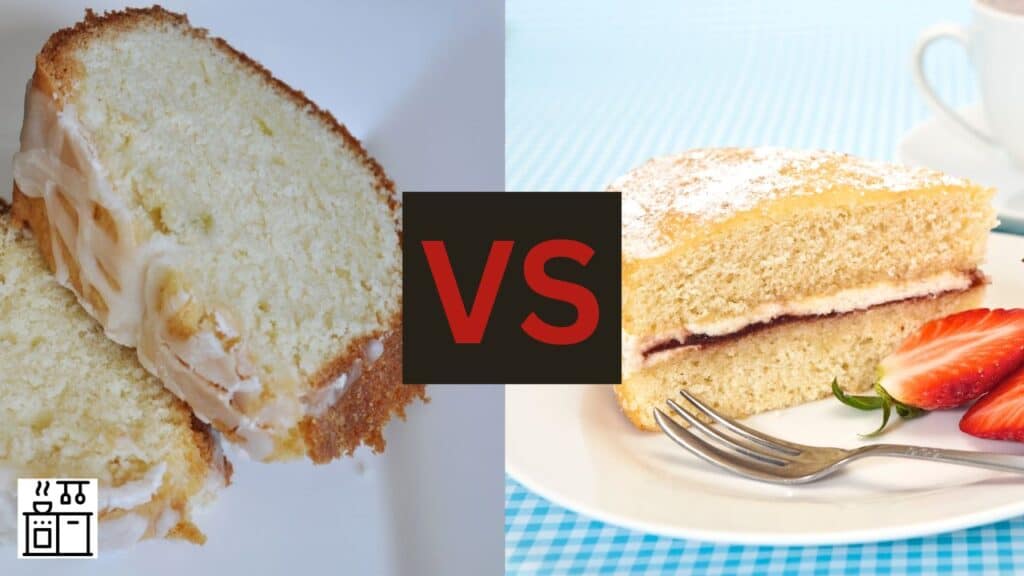Pound cake, as its name implies, is traditionally made with equal amounts of flour, butter, eggs, and sugar. This results in a dense, heavy, and richly flavored cake. Quite often, it is baked in a loaf pan or a Bundt mold and can be garnished with fruit or whipped cream.
On the other hand, sponge cake is primarily made with flour, eggs, and sugar, often without any butter. This leads to a light, airy, and subtle textured cake. Its versatility allows it to be used as a base for various other cakes. You can also easily adapt it with different flavor extracts.
Let’s now take a detailed look at the differences between pound cake and sponge cake.
- How Does the History of Pound Cake and Sponge Cake Differ?
- How Do the Main Ingredients of Pound Cake and Sponge Cake Differ?
- How Do the Textures of Pound Cake and Sponge Cake Differ?
- What Are the Flavor Differences Between Pound Cake and Sponge Cake?
- How Do the Common Uses and Variations of Pound Cake and Sponge Cake Differ?
How Does the History of Pound Cake and Sponge Cake Differ?
Let’s now talk about the rich history of pound cake and sponge cake.
History of Pound Cake
The pound cake traces its origins back to Northern Europe in the early 1700s. The first documented recipe was published in 1747.
This cake was distinctive due to its simple and memorable recipe, requiring a pound of butter, flour, sugar, and eggs.
This easily remembered four-ingredient recipe was popular at a time when many people couldn’t read.
Here are the pound cake’s characteristics:
- It had a rich, buttery taste from a pound of butter.
- The texture was firm yet light due to a pound of flour.
- It contained a sweet flavor from a pound of sugar.
- A pound of eggs provided binding and richness.
The pleasure of baking and sharing this uncomplicated and tasty cake was enjoyed by many.
History of Sponge Cake
The sponge cake originated in Spain, and its popularity spread rapidly across Europe. The name ‘sponge cake’ comes from its spongy texture.
The first recipe written in English was by poet Gervase Markham in 1615, but the cake was more like a cracker then.
The modern sponge cake we know today didn’t appear until the mid-18th century when bakers began to use beaten eggs to make the cake rise.
The crucial development happened in 1843 when Alfred Bird invented baking powder. This innovation made it possible to add butter to the recipe, which led to the creation of the Victoria sponge cake.
Today, sponge cakes are enjoyed in a variety of flavors and forms all over the world.
How Do the Main Ingredients of Pound Cake and Sponge Cake Differ?
The primary ingredients for pound cake are flour, sugar, butter, and eggs.
For sponge cake, you’ll need eggs, sugar, and flour.
These ingredients differentiate the two cakes from each other. Let’s take a deeper look.
Ingredients of Pound Cake
To make a pound cake, you will need to precisely measure equal parts of butter, sugar, eggs, and flour.
The cake gets its name from the traditional pound of each main ingredient used. This ensures the right balance and texture.
Here are the main ingredients of pound cake:
- A block of unsalted butter, softened at room temperature.
- A quantity of fine, granulated sugar.
- Several large eggs at room temperature.
- A portion of all-purpose flour, ready to provide structure.
In addition to these ingredients, you will also need a bowl and a whisk to make a pound cake.
Ingredients of Sponge Cake
Sponge cake primarily relies on eggs for structure and rising. Recipes often direct to separate, whip, and then combine the egg whites and yolks, which contributes to the cake’s light texture.
Granulated sugar is used for both sweetness and structure. The cake’s base is usually made from sifted all-purpose or cake flour.
Some recipes may include a small amount of fat, like butter, for added richness and flavor.
Occasionally, baking powder is used for additional rise.
How Do the Textures of Pound Cake and Sponge Cake Differ?

Pound cake has a dense, buttery texture. Sponge cake, on the other hand, has a light, airy crumb.
Texture of Pound Cake
A well-made pound cake has a distinct, dense, and moist texture. It also has a fine, crumbly crumb structure that is both soft and smooth.
This texture is the result of well-measured ingredients and precise preparation methods.
Here are the features of a pound cake:
- It has a dense and heavy texture, similar to a buttery cloud.
- It has a moist and rich flavor, making each bite enjoyable.
- It has a fine, crumbly structure that dissolves in your mouth, leaving a smooth aftertaste.
- It has a soft and smooth texture that feels silky on your palate.
- It has a lingering richness, tempting you to have another slice.
These attributes set a pound cake’s texture apart from other cakes.
Texture of Sponge Cake
A sponge cake has a light, airy texture that is different from denser desserts. This is due to the method of beating eggs and sugar together, which adds air to the batter.
The texture of a sponge cake is soft and delicate, contrasting with the heavier texture of a pound cake. It has a uniform crumb structure, giving it a spongy feel.
Additionally, it can absorb syrups, fillings, or creams, making it a good base for various desserts.
What Are the Flavor Differences Between Pound Cake and Sponge Cake?
Pound cake and sponge cake have unique flavors.
Flavor of Pound Cake
The flavor of pound cake is rich and buttery due to the high amount of butter in the recipe, providing a satisfying and indulgent texture.
The pound cake also has several other distinct yet subtle flavors:
- The cake’s sweetness is mild, making it an ideal match for your morning coffee or as a late-night snack.
- The taste and smell of vanilla are present, enhancing the overall flavor of the cake.
- Sour cream adds a slight tang to the cake, providing an unexpected twist to the taste.
- Other flavor additions like coconut, lemon, or rum enhance the flavor of the simple pound cake.
Flavor of Sponge Cake
Sponge cake has a unique taste, offering mild sweetness and faint hints of vanilla. It doesn’t contain added fat, giving it a light and balanced flavor.
The sponge cake base is versatile and can soak up different flavors and syrups.
You can easily change its taste by adding lemon, almond, chocolate, coconut, or orange extracts.
The flavor of sponge cake can also be enhanced with light frostings, jams, or whipped cream.
| Flavor Feature | Sponge Cake |
|---|---|
| Sweetness | Mild |
| Vanilla Undertones | Faint |
| Fat Content | None added |
| Versatility | High |
How Do the Common Uses and Variations of Pound Cake and Sponge Cake Differ?
Pound cake and sponge cake are both versatile and adaptable.
Pound cake, known for its rich taste, is commonly used in layered desserts, as a base for fruit toppings, or simply served with a dusting of powdered sugar.
Sponge cake, on the other hand, is light and airy. It’s often used in making rolled cakes and trifle dishes or enjoyed with a simple glaze or cream.
Both these cakes can be adjusted to fit different tastes and occasions.
Uses and Variations of Pound Cake
Pound cakes provide a variety of baking options in terms of shapes, serving styles, and flavors.
You can tailor a pound cake recipe to your taste. Here are a few possibilities:
- Use a loaf pan or Bundt mold for a unique cake shape.
- Serve it with powdered sugar, glaze, or icing. Pair it with fruit or whipped cream for added flavor.
- Enhance the taste with flavors like vanilla, almond, lemon, or chocolate.
- Add sour cream for extra moisture and a tangy twist.
- Try different cultural versions of the pound cake. For instance, France’s ‘quatre-quarts’ uses equal parts of the main ingredients.
Related: Angel Food Cake vs. Sponge Cake | Angel Food Cake vs. Pound Cake
Uses and Variations of Sponge Cake
Sponge cake is highly adaptable and can be used in various desserts. It can be served plain, with powdered sugar, or light icings.
Its light texture makes it suitable for layered cakes, complementing different fillings and frostings.
It’s absorbent, making it perfect for cake rolls and soaked cakes such as Tres Leches.
The base recipe can be modified with extracts like lemon, almond, chocolate, coconut, orange, or vanilla to suit individual tastes.
There are also cultural variations, such as the British Victoria sponge cake.

